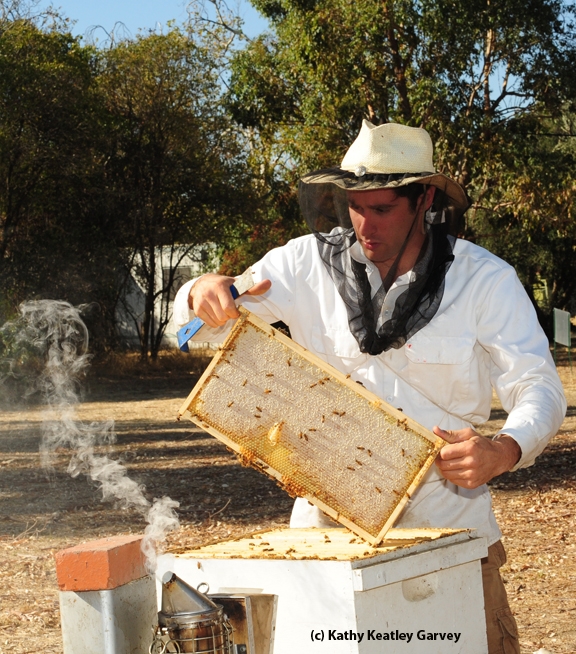
This is the time of year when scores of prospective beekeepers contact Extension apiculturist Eric Mussen of the UC Davis Department of Entomology and Nematology for advice on beginning beekeeping.
Many want to keep a hive or two in their backyards but don't know where to start.
It's not as simple as purchasing a queen bee off the Internet. You have to buy packaged bees or collect a swarm to start a colony.
"If you haven't started (beginning beekeeping) yet, purchasing a honey bee queen won't do it," Mussen advised a Northern California woman today. "You need 2-3 pounds (6-9,000 bees) of worker bees to get things going. So, the new beekeeper usually either buys 'packaged bees' or collects a swarm."
"Individual queens are purchased to replace queens in colonies that already are going, or to add to frames of bees and brood--not including the old queen--that are removed from a strong colony, later in the season. That is called 'splitting' or 'dividing' the colony to get a total of two.
Mussen, who joined UC Davis in 1976 and will be retiring in June, always advises newcomers to join a local beekeeping association and read magazines and books.
"As for textbooks, it depends on how the bees are going to be kept. In what I refer to as 'normal' Langstroth hives, the book Beekeeping for Dummies is relatively good," Mussen told her. "If the bees are headed for a top-bar hive, then Les Crowder's book on that subject is reasonably priced. Smaller 'backyard' texts have recently been published by UC Davis emeritus professor Norman Gary (Honey Bee Hobbyist: the Care and Keeping of Bees); Bee Culture magazine editor Kim Flottum (The Backyard Beekeeper: An Absolute Beginner's Guide to Keeping Bees in Your Yard and Garden), and University of Florida emeritus professor Malcolm Sanford, who is the co-author with Richard E Bonney of Storey's Guide to Keeping Honey Bees: Honey Production, Pollination, Bee Health.

Mussen also pointed out that a newly revised rendition of the beekeeping bible, The Hive and the Honey Bee will soon replace the 1992 edition. "It is one of the most comprehensive texts out there," he said.
Beekeeping periodicals include The American Bee Journal, Bee Culture magazine and the Speedy Bee newspaper.
What about keeping bees along a busy street?
"Having a busy thoroughfare over your back fence will be problematic only if most of the bee-attractive water and flowers producing nectar and pollen are on the other side of the road," Mussen noted. "Then a bunch of the bees will become hood ornaments or windshield smudges. Be sure to have a good bee-watering set-up in place before the bees are moved in."
Prospective beekeepers also need to contact their local Cooperative Extension office for rules and regulations.
One very enduring part of being a first-year beekeeper: "The first year should be the smoothest," he said. "After that, pests and diseases become a concern."
Musssen writes a bimonthly newsletter, from the UC Davis apiaries, which can be downloaded free from his website. He also writes the periodic Bee Briefs and one includes Getting Started in Beekeeping.
Attached Images:
